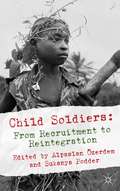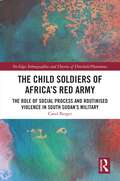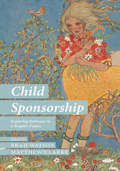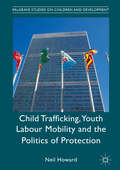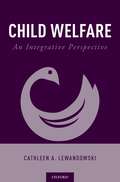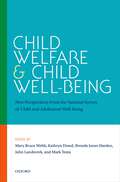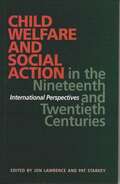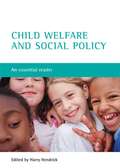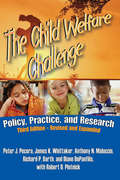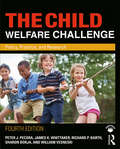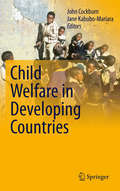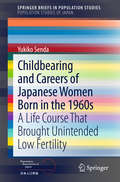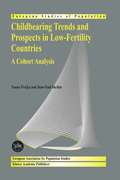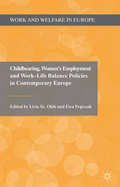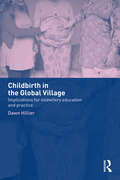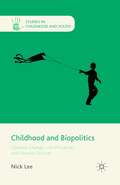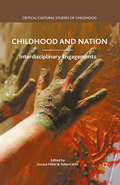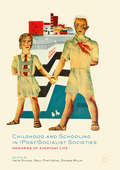- Table View
- List View
Child Soldiers: From Recruitment to Reintegration
by Alpaslan Özerdem Sukanya PodderThis book examines the complex and under-researched relationship between recruitment experiences and reintegration outcomes for child soldiers. It looks at time spent in the group, issues of cohesion, identification, affiliation, membership and the post demobilization experience of return, and resettlement.
The Child Soldiers of Africa's Red Army: The Role of Social Process and Routinised Violence in South Sudan's Military (On Edge: Ethnographies and Theories of Threshold Phenomena)
by Carol BergerThis book examines the role of social process and routinised violence in the use of underaged soldiers in the country now known as South Sudan during the twenty-two-year civil war between Sudan’s northern and southern regions. Drawing on accounts of South Sudanese who as children and teenagers were part of the Red Army—the youth wing of the Sudan People’s Liberation Army (SPLA)— the book sheds light on the organised nature of the exploitation of children and youth by senior adult figures within the movement. The book also includes interviews with several of the original Red Army commanders, all of whom went on to hold senior positions within the military and government of South Sudan. The author chronicles the cultural transformation experienced by members of the Red Army and considers whether an analysis of the processes involved in what was then Africa’s longest civil war can aid our understanding of South Sudan’s more recent descent into ethnicised conflict. As such, it will appeal to scholars of sociology, anthropology and political science with interests in ethnography, conflict and the military exploitation of children.
The Child Soldiers of Africa's Red Army: The Role of Social Process and Routinised Violence in South Sudan's Military (On Edge: Ethnographies and Theories of Threshold Phenomena)
by Carol BergerThis book examines the role of social process and routinised violence in the use of underaged soldiers in the country now known as South Sudan during the twenty-two-year civil war between Sudan’s northern and southern regions. Drawing on accounts of South Sudanese who as children and teenagers were part of the Red Army—the youth wing of the Sudan People’s Liberation Army (SPLA)— the book sheds light on the organised nature of the exploitation of children and youth by senior adult figures within the movement. The book also includes interviews with several of the original Red Army commanders, all of whom went on to hold senior positions within the military and government of South Sudan. The author chronicles the cultural transformation experienced by members of the Red Army and considers whether an analysis of the processes involved in what was then Africa’s longest civil war can aid our understanding of South Sudan’s more recent descent into ethnicised conflict. As such, it will appeal to scholars of sociology, anthropology and political science with interests in ethnography, conflict and the military exploitation of children.
Child Sponsorship: Exploring Pathways to a Brighter Future
by Matthew Clarke Brad WatsonThis book reviews the remarkable growth, diversity and challenges of child sponsorship. It features the latest progress in child sponsorship practice and necessary tensions experienced by some organisations as they seek to maximise impact.
Child Trafficking, Youth Labour Mobility and the Politics of Protection (Palgrave Studies on Children and Development)
by Neil HowardThis book provides the first overarching, empirically grounded, critical analysis of child trafficking as an idea, ordering principle, and artefact of politics. It examines (once) hegemonic anti-child trafficking discourse, policy and practice, and does so by placing secondary literature from around the world in conversation the author’s paradigmatic case study of the situation in southern Benin. It deconstructs the child trafficking paradigm, contrasts it with ‘real’ histories of child and youth labour and mobility, and seeks to explain it by going ‘inside’ the anti-trafficking field. In doing so, Howard tells a gripping story of ideology at work.
Child Welfare: An Integrative Perspective
by Cathleen A. LewandowskiOrganized around the theme of child well-being, this book provides an overview of child welfare's past and present with consideration of its future. Using case examples and discussion questions, this text engages readers in a critical examination of the challenges and strategies used to date to suggest possible directions for promoting the well-being of all children. Meanwhile, the "whole child" integrative approach to child welfare uniquely examines strategies to address children's physical, emotional, social, and psychological needs. Child welfare policy and practices are integrated throughout, thereby illustrating the context in which child welfare practice occurs and how practice and policy are connected. Current issues guiding practice with children who are especially at-risk are also explored, including children with disabilities, immigrant children, and youth who may have been trafficked. Child Welfare is a rich resource for social work students, child welfare practitioners, and administrators alike.
Child Welfare: An Integrative Perspective
by Cathleen A. LewandowskiOrganized around the theme of child well-being, this book provides an overview of child welfare's past and present with consideration of its future. Using case examples and discussion questions, this text engages readers in a critical examination of the challenges and strategies used to date to suggest possible directions for promoting the well-being of all children. Meanwhile, the "whole child" integrative approach to child welfare uniquely examines strategies to address children's physical, emotional, social, and psychological needs. Child welfare policy and practices are integrated throughout, thereby illustrating the context in which child welfare practice occurs and how practice and policy are connected. Current issues guiding practice with children who are especially at-risk are also explored, including children with disabilities, immigrant children, and youth who may have been trafficked. Child Welfare is a rich resource for social work students, child welfare practitioners, and administrators alike.
Child Welfare And Child Well-being C: New Perspectives From The National Survey Of Child And Adolescent Well-being
by Mark Testa Mary Bruce Webb Kathryn Dowd Brenda Jones Harden John LandsverkChild Welfare and Social Action from the Nineteenth Century to the Present
by Jon Lawrence Pat StarkeyThis collection of twelve essays represents an important contribution to the understanding of child welfare and social action in the nineteenth and twentieth centuries. They challenge many assumptions about the history of childhood and child welfare policy and cover a variety of themes including the physical and sexual abuse of children, forced child migration and role of the welfare state.
Child Welfare And Social Policy: An Essential Reader (PDF)
by Harry HendrickThis book provides an essential one-stop introduction to the key concepts, issues, policies and practices affecting child welfare, with particular emphasis on the changing nature of the relationship between child welfare and social policy. No other book brings together such a wide selection of material to form an attractive and indispensable teaching and learning resource. Child welfare and social policy provides readers with an historical overview of child welfare in England and Wales; high quality contributions from leading authorities in the field; discursive introductions to each section that set individual chapters in the broader context of childhood studies and case study material to bring discussions to life. Key topics covered include morality and child welfare; relations between law, medicine, social work, social theory and child welfare; children's rights and democratic citizenship and children as raw material for 'social investment'. Child welfare and social policy is invaluable reading for students and academics in social policy, sociology, education and social work. It is also a useful resource for health and social work professionals wishing to follow current debates in theory and practice.
The Child Welfare Challenge: Policy, Practice, and Research
by Richard P. Barth Dianne DepanfilisWithin a historical and contemporary context, this book examines major policy practice and research issues as they jointly shape child welfare practice and its future. In addition to describing the major problems facing the field, the book highlights service innovations that have been developed in recent years. The resulting picture is encouraging, especially if certain major program reforms I are implemented and agencies are able to concentrate resources in a focused manner. The volume emphasizes families and children whose primary recourse to services has been through publicly funded child welfare agencies. The book considers historical areas of service—foster care and adoptions, in-home family-centered services, child-protective services, and residential services—where social work has an important role. Authors address the many fields of practice in which child and family services are provided or that involve substantial numbers of social work programs, such as services to adolescent parents, child mental health, education, and juvenile justice agencies. This new edition will continue to serve as a fundamen-tal introduction for new practitioners, as well as summary of recent developments for experienced practitioners.
The Child Welfare Challenge: Policy, Practice, and Research
by Richard P. Barth Dianne DepanfilisWithin a historical and contemporary context, this book examines major policy practice and research issues as they jointly shape child welfare practice and its future. In addition to describing the major problems facing the field, the book highlights service innovations that have been developed in recent years. The resulting picture is encouraging, especially if certain major program reforms I are implemented and agencies are able to concentrate resources in a focused manner. The volume emphasizes families and children whose primary recourse to services has been through publicly funded child welfare agencies. The book considers historical areas of service—foster care and adoptions, in-home family-centered services, child-protective services, and residential services—where social work has an important role. Authors address the many fields of practice in which child and family services are provided or that involve substantial numbers of social work programs, such as services to adolescent parents, child mental health, education, and juvenile justice agencies. This new edition will continue to serve as a fundamen-tal introduction for new practitioners, as well as summary of recent developments for experienced practitioners.
The Child Welfare Challenge: Policy, Practice, and Research (Modern Applications of Social Work Series)
by Peter J. Pecora James K. Whittaker Richard P. Barth Sharon Borja William VesneskiUsing both historical and contemporary contexts, The Child Welfare Challenge examines major policy practice and research issues as they jointly shape child welfare practice and its future. This text focuses on families and children whose primary recourse to services has been through publicly funded child welfare agencies, and considers historical areas of service—foster care and adoptions, in-home family-centered services, child-protective services, and residential treatment services—where social work has an important role. This fourth edition features new content on child maltreatment and prevention that is informed by key conceptual frameworks informed by brain science, public health, and other research. This edition uses cross-sector data and more sophisticated predictive and other analytical processes to enhance planning and practice design. The authors have streamlined content on child protective services (CPS) to allow for new chapters on juvenile justice/cross-over youth, and international innovations, as well as more content on biology and brain science. The fourth edition includes a glossary of terms as well as instructor and student resource papers available online.
The Child Welfare Challenge: Policy, Practice, and Research (Modern Applications of Social Work Series)
by Peter Pecora James Whittaker Richard Barth Sharon Borja William VesneskiUsing both historical and contemporary contexts, The Child Welfare Challenge examines major policy practice and research issues as they jointly shape child welfare practice and its future. This text focuses on families and children whose primary recourse to services has been through publicly funded child welfare agencies, and considers historical areas of service—foster care and adoptions, in-home family-centered services, child-protective services, and residential services—where social work has an important role. This fourth edition features new content on child maltreatment and prevention that is inspired by key conceptual frameworks, such as the World Health Organization social determinants of health paradigm, the CDC prevention taxonomy, and a protective factors ecological diagram published by the U.S. Children’s Bureau. This edition uses cross-sector data and more sophisticated predictive and other analytical processes to enhancing planning and practice design. The authors have streamlined content on child protective services (CPS) to allow for new chapters on juvenile justice/cross-over youth, and international innovations, as well as more content on biology and brain science. The fourth edition includes a glossary of terms as well as a companion website with instructor resources and pdfs of the book’s appendices.
Child Welfare in Developing Countries
by John Cockburn Jane Kabubo-Mariarato establish impact, attributing observed changes in welfare to the intervention, while identifying key factors of success. Impact evaluations are aimed at providing feedback to help improve the design of programs and policies. They also provide greater accountability and a tool for dynamic learning, allowing policymakers to improve ongoing programs and ultimately better allocate funds across programs. Such a causal analysis is essential for understanding the relative role of alternative interventions in reducing poverty. The papers in this section again adopt a variety of techniques. The rst two impact evaluation studies employ propensity score matching to establish, ex-post, a valid control group to assess the impact on child schooling outcomes among b- e ciaries of various interventions in Kenya and Ethiopia. The third chapter c- ries out an ex-ante evaluation of alternative cash transfer programs on child school attendance in Uruguay. The nal paper further carries out in-depth macro-modeling and micro-regression analysis to simulate the impacts of the food crisis and various policy responses, including food subsidies and cash transfers, on various dimensions of child poverty in Mali. Though using different approaches, the studies are gen- ally in agreement concerning the positive impact of the cash transfer program on child schooling and labor market outcomes. The studies from Kenya and Uruguay both nd that the schooling interventions are progressive.
Child Welfare Services for Minority Ethnic Families: The Research Reviewed (PDF)
by Ashok Chand Joanne Procter June ThoburnBased on extensive studies into child welfare services, this important book brings together research into what works in service provision for minority ethnic families. Reviewing studies of the nature and adequacy of the services provided, and the outcomes for the children and their families, this book provides much-needed guidance for policy and practice around issues of cultural and ethnic background and identity, and puts forward suggestions for future research. The authors consider in particular: * the complex needs and identities of minority ethnic families who might use child welfare services * how families using social services view current practice * the impact of the formal child protection and court systems on ethnic minority families * placement patterns and outcomes for children from the different minority ethnic groups who are in residential care, foster care or adopted * cultural issues and `matching' the social worker to the family. Drawing on current government statistical returns and the 2001 national census, this wide-ranging analysis challenges dated research and practice and proposes a revisionary agenda for future research and culturally sensitive child welfare practice, making it essential reading for all child welfare professionals.
Child well-being, child poverty and child policy in modern nations (Revised 2nd Edition): What do we know?
by Timothy M. Smeeding Koen VleminckxChild poverty and the well-being of children is an important policy issue throughout the industrialised world. Some 47 million children in 'rich' countries live in families so poor that their health and well-being are at risk. The main themes addressed are: · the extent and trend of child poverty in industrialised nations; · outcomes for children - for example, the relationship between childhood experiences and children's health; · country studies and emerging issues; · child and family policies. All the contributions underline the urgent need for a comprehensive policy to reduce child poverty rates and to improve the well-being of children. Findings are clearly presented and key focus points identified for policy makers to consider.
Childbearing and Careers of Japanese Women Born in the 1960s: A Life Course That Brought Unintended Low Fertility (SpringerBriefs in Population Studies)
by Yukiko SendaThis book provides the keys to understanding the trajectory that Japanese society has followed toward its lowest-low fertility since the 1980s. The characteristics of the life course of women born in the 1960s, who were the first cohort to enter that trajectory, are explored by using both qualitative and quantitative data analyses. Among the many books explaining the decline in fertility, this book is unique in four ways. First, it describes in detail the reality of factors concerning the fertility decline in Japan. Second, the book uses both qualitative and quantitative methods to introduce the whole picture of how the low-fertility trend began in the 1980s and developed in the 1990s and thereafter. Third, the focus is on a specific birth cohort because their experiences determined the current patterns of family formation such as late marriage and postponed childbirth. Fourth, the book explores the knife-edge balance between work and family conditions, especially with regard to childbearing, in the context of Japanese management and gender norms. After examining the characteristics of demographic and socioeconomic circumstances of postwar Japan in detail, it can be seen that the change in family formation first occurred drastically in the 1960s cohort. Using both qualitative interview data cumulatively from 150 people and quantitative estimates with official statistics, this book shows how individual-level choices to balance work and family obligations resulted in a national-level fertility decline. Another focus of this book is the increasing unintended infertility due to postponed pregnancy, a phenomenon that is attracting great social attention because the average age of pregnancy is approaching the biological limit. This book is a valuable resource for researchers who are interested in the rapid fertility decline as well as the work–life balance and the life course of women in Japanese employment practice and family traditions.
Childbearing Trends and Prospects in Low-Fertility Countries: A Cohort Analysis (European Studies of Population #13)
by Tomas Frejka Jean-Paul Sardon"This is a tour de force in cohort fertility analysis, a deep and powerful piece of work. It is a striking demonstration of the force of really detailed empirical analysis of excellent and comprehensive data, with the data looked at from every angle and judiciously extrapolated into the future. It represents a major contribution to our understanding of contemporary low fertility in Europe and other developed nations..." Thomas K. Burch, University of Victoria, BC, Canada
Childbearing, Women's Employment and Work-Life Balance Policies in Contemporary Europe (Work and Welfare in Europe)
by Ewa FratczakThis volume addresses the relationship between childbearing, paid work and work-life balance policies across Europe in the 21st century, illuminating the uncertainty and risk related to insecure labour force attachment, the incoherence of women's and men's access to education and employment and the unequal share of domestic responsibilities.
Childbirth in the Global Village: Implications for Midwifery Education and Practice
by Dawn HillierIs the experience of childbirth becoming 'globalised'?Is the encroachment of the western medical model dehumanising a profoundly human experience?If so, what can midwives and midwife educators do about it?These are the questions at the heart of Childbirth in the Global Village which highlights the role that globalisation plays in changing childbirth practices and its implications for midwifery practice and education.Built around the vivid personal stories of women and midwives experiencing childbirth in four very different cultures Childbirth in the Global Village will resonate with the experience of midwives everywhere and makes a strong case for redesigning the midwifery curriculum to reflect the interconnectedness of childbirth, midwifery education and practice around the globe.
Childbirth in the Global Village: Implications for Midwifery Education and Practice
by Dawn HillierIs the experience of childbirth becoming 'globalised'?Is the encroachment of the western medical model dehumanising a profoundly human experience?If so, what can midwives and midwife educators do about it?These are the questions at the heart of Childbirth in the Global Village which highlights the role that globalisation plays in changing childbirth practices and its implications for midwifery practice and education.Built around the vivid personal stories of women and midwives experiencing childbirth in four very different cultures Childbirth in the Global Village will resonate with the experience of midwives everywhere and makes a strong case for redesigning the midwifery curriculum to reflect the interconnectedness of childbirth, midwifery education and practice around the globe.
Childhood and Biopolitics: Climate Change, Life Processes and Human Futures (Studies in Childhood and Youth)
by N. LeeWill the future be a climate disaster? Will biotechnologies bring huge improvements to lifespan? Predictions vary, but children's status as human embodiments of the future puts them at the centre of attempts to shape the world and the discipline of childhood studies can therefore make a critical and creative contribution to future-making.
Childhood and Nation: Interdisciplinary Engagements (Critical Cultural Studies of Childhood)
by Robert Imre Zsuzsanna MilleiChildhood and Nation explores the historical and manifold current relations between nation and childhood. Millei and Imre bring together an international and interdisciplinary group of scholars to address many pressing questions of today. The analytical incisions created by nation and childhood bring answers to the following questions: How do national agendas related to economic, social and political problems exploit children and tighten their regulation? How do representations of nations take advantage of ideals of childhood? Why do nations look to children and search for those characteristics of childhood that help them solve environmental and humanitarian issues? The book offers a fresh look at the theme of nation and childhood by offering multiple methodologies from fields including education, policy studies, political science, sociology, anthropology, literature, and psychology.
Childhood and Schooling in (Post)Socialist Societies: Memories of Everyday Life (PDF)
by Iveta Silova Nelli Piattoeva Zsuzsa MilleiThis book explores childhood and schooling in late socialist societies by bringing into dialogue public narratives and personal memories that move beyond imaginaries of Cold War divisions between the East and West. Written by cultural insiders who were brought up and educated on the eastern side of the Iron Curtain - spanning from Central Europe to mainland Asia - the book offers insights into the diverse spaces of socialist childhoods interweaving with broader political, economic, and social life. These evocative memories explore the experiences of children in navigating state expectations to embody “model socialist citizens” and their mixed feelings of attachment, optimism, dullness, and alienation associated with participation in “building” socialist futures. Drawing on the research traditions of autobiography, autoethnography, and collective biography, the authors challenge what is often considered ‘normal’ and ‘natural’ in the historical accounts of socialist childhoods, and engage in (re)writing histories that open space for new knowledges and vast webs of interconnections to emerge. This book will be compelling reading for students and researchers working in education, sociology and history, particularly those within the interdisciplinary fields of childhood and area studies.‘The authors of this beautiful book are professional academics and intellectuals who grew up in different socialist countries. Exploring “socialist childhoods” in myriad ways, they draw on memories, and collective history, emotional insider knowledge and the measured perspective of an analyst. What emerges is life that was caught between real optimism and dullness, ethical commitments and ideological absurdities, selfless devotion to children and their treatment as a political resource. Such attention to detail and examination of the paradoxical nature of this time makes this collective effort not only timely but remarkably genuine.’ —Alexei Yurchak, University of California, USA
